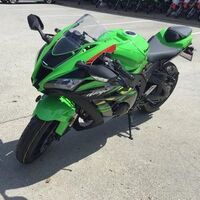USED / SECOND HANDED 2011 YAMAHA YZF R1
-
Supplier: G AND B EXP IMP PTY LTD -
Region: NORTH WEST, South Africa -
Contact: Davila Martinez Leonel -
Price: $1000.00 /piece -
Min. Order: 1 piece
| Certification: | ce; | Displacement: | 200cc; |
| Type: | Pocket Bike; | Motor: | Brushless; |
| Power: | 1001 - 2000W; | Payment Terms: | T/T,Western Union,MoneyGram; |
| Condition: | Used; | Packaging Detail: | Bulk; |
| Place of Origin: | USA; | Fuel: | Gas / Diesel; |
| Engine Type: | 4-Stroke; | Voltage: | 60V; |
| Port: | Thailand; | Brake(F/R): | Disc; |
| Max. Speed: | > 80km/h; | Supply Ability: | 10 Piece/Pieces per Day; |





 Featuring next-generation R-Series styling, sophisticated electronic control, enhanced braking and suspension performance, and a refined crossplane engine.
Featuring next-generation R-Series styling, sophisticated electronic control, enhanced braking and suspension performance, and a refined crossplane engine.
Features may include:
ENGINE
- Cutting-Edge CP4® Engine
The R1’s 998cc inline-four-cylinder engine features Yamaha’s exclusive crossplane crankshaft technology derived from the YZR-M1 MotoGP® machine. By equalizing inertial forces at the crankshaft, the CP4 motor delivers a direct feeling of linear torque, giving the rider the ultimate connection between throttle grip and the rear wheel.
- High-Output Engine Technology
Titanium connecting rods use Yamaha’s precision fracture-split method to ensure reliability with minimal weight. Combined with titanium intake valves and forged pistons, these lightweight parts help achieve the CP4’s high redline and over-rev capability. The cylinder block is also offset from the crankshaft, reducing friction loads on the pistons and bores.
- New Intake System
For 2011, a new cylinder head, intake system, fuel injectors and airbox work together to enhance part-throttle performance. And by creating a smaller and shorter intake tract, new Bosch® injectors are able to spray fuel directly against the intake valves, for improved fuel atomization.
CHASSIS/SUSPENSION
- New Öhlins® Gas-Charged NPX Fork
For 2011, the YZF-R1M features Öhlins® latest NPX fork system. By utilizing a pressurized nitrogen chamber similar to a rear shock, oil cavitation is essentially eliminated to deliver consistent damping under the toughest conditions with unmatched ride quality and feel.
- Dynamic Öhlins® Electronic Racing Suspension (ERS)
The YZF-R1M features the advanced Öhlins® ERS system. The motorcycle’s IMU sends vehicle data—such as vehicle speed, lean angle, acceleration and brake pressure—to a dedicated Suspension Control Unit (SCU) which rapidly adjusts the front and rear damping in real time for optimum suspension performance whether braking, cornering, or accelerating. The ERS provides streamlined dynamic tuning modes for both street and track, as well as manual modes for conventional suspension tuning with fixed damping.
- New Brake Control (BC) System with ABS
Developed on racetracks around the world, Yamaha’s new Brake Control system works with an Antilock Braking System (ABS) to minimize brake slip under aggressive braking, or on less than ideal surfaces. The adjustable BC system uses the IMU to provide progressive brake force intervention as lean angle increases, to boost rider confidence when braking mid-corner.
-
High-speed gasoline sports motorcycle 400cc two-wheel racing urban road motorcycle

-
Best Selling 200cc 250cc 400CC Petrol Sport Engine V6 ABS Motocross Racing Motorcycle

-
Dirt Bike Motorcycles 2023 Kawasaki 2022 KLX300R - Dirt Bikes Kawasaki KX 250cc X 2 Stroke

-
Sports bike R1250GS /R1250GS best sale original brand new discount sale

-
Dirt bike 110cc 125cc dirt bike 150cc dirt bike

-
300cc/400cc Chopper Cruiser Engine Gas Moped Vintage 2 Wheels Large Bicycle Motorcycle Moto Bike

-
Two-cylinder water-cooled 400CC adult racing car

-
Affordable Electric Bike R1250GS/R1250GS

-
Factory sells all kinds of widely used off-road racing suitable exhaust adult racing electric motorcycle

-
2022 latest Chopper 400CC Zongshen water-cooled twin-cylinder engine EFI ABS off-road racing fuel sports racing motorcycle

Other Products
-
 $1642.05 / piece
$1642.05 / piece -
 $1086.40 / piece
$1086.40 / piece -
 $2189.40 / piece
$2189.40 / piece -
 $2183.20 / piece
$2183.20 / piece -
 $754.53 / piece
$754.53 / piece -
 $758.87 / piece
$758.87 / piece

















